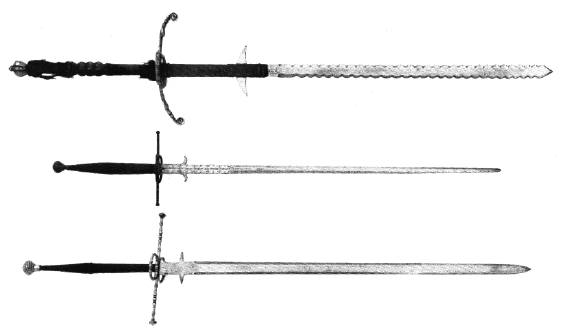Clearing up the sword haze
Sledge said:
I thoroughly suggest you read the articles. I've already quoted it, so I won't quote it again. If you read it you will note that they describe more than one sword over 7 pounds.
http://www.thearma.org/essays/2HGS.html lists a huge number of swords, and then posts an average weight of 7.8 pounds.
Ok, I'm going to try to clear this up once and for all.
The article you are linked to refers to a special type of sword. If you look at the many photos in the article you will see that this is in fact a six foot sword, as long or longer than the wielder, and with a 12" or more ricasso for choking up on the blade ('half swording') and usually featuring permanent lugs just abive this ricasso.
This is a 16th century specialist infantry weapon designed for pike combat in the era of cannons and firearms. In use and function it's more like a halberd than a sword in many ways.
The real source of confusion is due to the problem, which you raised earlier and I also brought up, of the use of nomenclature in the historical community and in D&D.
Because there wasn't really an historical name for these relative oddities which distinguishes it from more normal swords. Modern hoplologists (there is a word predating ARMA) have referred to it as a 'zweihander' or 'bidenhander' or 'dopplehander' or a 'True two handed sword' since you definately could never wield one of these six foot monsters with one hand.
The bihander can indeed weigh up to 6-8 pounds, but I do not believe this is the weapon in D&D however, for a variety of reasons I'll explain below. (You couldn't get this into any dungeon or use it indoors for one thing, since you need about 10' of space in all directions. For another it's not a knightly weapon, or a medieval weapon...)
The bihander
http://en.wikipedia.org/wiki/Zweihander
Here are the real world equivalents of your typical D&D swords:
ARMING SWORD (real world) = LONG SWORD (D&D)
Oakeshott types X, Xa, XII, XIV, XV, XVI etc.
Your basic cut and thrust, single handed knightly weapon. Usually used with a shield. Evolved from the earlier Viking type swords, features a broad but pointy blade suitible for both cutting and thrusting, a heavy pommel to balance the weapon 4-6" from the guard and a prominent cross guard or quillion.
34"=42" long, single handed, 2-4 lbs
Longsword / Bastard Sword (real world) = Bastard Sword (D&D)
Oakeshott XVa, XVII, XVIIIb etc.
Your late medieval knightly weapon. Carried on the saddle normally often without a scabbard. Heavy pommel and a Hand and a Half grip. Pointy but stiff blade often featuring a chisel-like cross section for standing up to armor, suitible for both cutting and thrsuting.
42"-50" long, two handed, 2-4 lbs
Longsword / Warsword / Greatsword (real world) = Great Sword (D&D)
A subtype of the longsword, both the first and last types in use. Hand and a Half Grip, Point of Balance 4-6" from the cross. A flatter blade more specialized for cutting than thrusting, and specifically more for cutting less heavily armored targets.
46"-52" long, two handed, 3-4.5 lbs
I really think this last one is the one in D&D. Why? It's was a knightly weapon. At four feet long it's formidable but not ridiculous. You could use it in a large room. It existed before the battlefields were dominated by guns and cannons.
When people talk about medieval swords, this is thie biggest (and heaviest type)
For example, if you had done perhaps a little more digging you might have noticed the link on the bottom of that article to Johns other article on
Medieval swords, entitled "What did medieval swords weigh?" (It would seem to stand out as being RIGHT on topic!
http://www.thearma.org/essays/weights.htm
Allow me to quote from this useful piece:
"From ordinary hands-on experience we know full well that swords were not excessively heavy nor did they weigh 10 or 15 pounds and more. (snip)
For example, the lengthy catalog of swords from the famed Wallace Collection Museum in London readily lists dozens of fine specimens among which it is difficult to find any weighing in excess of 4 pounds. Indeed, the majority of specimens, from arming swords to two-handers to rapiers, weigh much less than three pounds. "
he goes on to say..
"Despite frequent claims to the contrary,
Medieval swords were indeed light, manageable, and on average weighed less than four pounds. As leading sword expert Ewart Oakeshott unequivocally stated: "Medieval Swords are neither unwieldably heavy nor all alike - the average weight of any one of normal size is between 2.5 lb. and 3.5 lbs. Even the big hand-and-a-half 'war' swords rarely weigh more than 4.5 lbs.
I hope that helps clear it up for you.
So your research into sword forms is not grown out of ARMA then? I apologize for being mistaken.
"Forms" usually means drills like a kata, or it could theoretically mean the shape of a sword? I have studied both primarily on my own, though I have used ARMA (and HACA before that) as a resource as well as some other groups. I'm also not a member of ARMA though I have trained with some of their members.
You said there were numerous surving 15th & 16th century treatises on how to fight with swords. Can you please tell me some titles. I would be interested in reading these.
They are too numerous to name off the top of my head. You can find several here
http://www.thearma.org/manuals.htm
including the I.33 manual (1295 AD) Hanko Dobringers Fechtbuch (1389) Flos Deullatorum (1410) Sigmund Ringeck Fechtbuch (which I have studied) (1440 AD) Tallhoffers Fechtbuch (1443) Codex Wallerstein (1470) etc. etc. etc., just to name a few of the earlier ones.
BD













